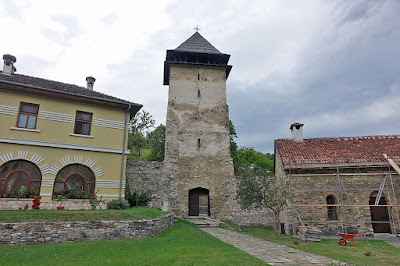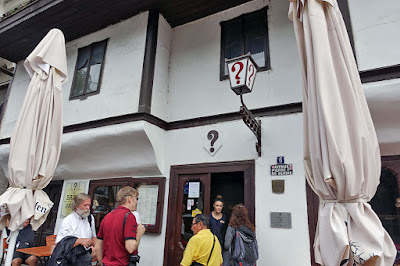Day 1: Arrival in Belgrade
I arrived in Belgrade (via Austrian Airlines) a day before the tour started, so I had part of a day to walk around the center of the city. As European cities go, Belgrade is not particularly attractive, and a lot of it seemed to be in a state of disrepair/neglect and/or covered in graffiti.
 |
| Baggage claim at Nikola Tesla International Airport |
In Belgrade, my home was the
Hotel Moskva, a "classic" hotel, which opened in 1908. Just about every famous person who visited Belgrade stayed there. The hotel is between Republic Square and the Parliament building on the map above.
 |
| Hotel Moskva |
After checking in to the hotel, I wandered the center of the city to take some photos and people-watch.
 |
| Square in front of the hotel |
 |
| More buildings near the hotel |
 |
| A demonstration in front of the National Museum |
 |
| Another demonstration |
I stopped for dinner at
Zlatno Burence, a typical Serbian restaurant, where nobody spoke English. Nevertheless, I persisted.
Day 2: A Tour of Belgrade
This morning I met my tour mates in the hotel lobby and we embarked on a tour of Belgrade. Our tour leader was Dragana, who owns a local tour agency.
 |
| Me and my Fellow Travelers (picture taken later in the trip) |
When we walked out of the hotel, we discovered that it was surrounded by local police. Apparently there was going to be a Gay Pride parade, but we never encountered it.
 |
| The local constabulary |
One of the first sights we encountered was a building that had been partially destroyed when NATO bombed Belgrade during the Balkan war in the early 1990's. The building was never repaired.
 |
| Building bombed by NATO |
We then drove through New Belgrade (on the west side of the Sava River on the map at the top of this page), an area that was developed in the 1970's and 1980's. Most of it is Soviet-style apartment buildings.
 |
| An apartment building in New Belgrade |
We then headed west to
Zemun, a town on the outskirts of Belgrade that has been incorporated into the city. Zemun had lots of 19th century buildings in various states of condition.
 |
| Zemun |
 |
| Another shot of Zemun |
We then returned to the older part of Belgrade, to the east of the Sava River. We first drove through a nicer area that housed several embassies.
 |
| A house in the embassy area. |
Next we stopped at the
mausoleum of
Josep Broz Tito, who was the leader of Yugoslavia from 1945 to 1990.
 |
| Tito's grave |
 |
| Two important world leaders |
Next stop was the Church of St. Sava, one of the largest churches in the world. Construction was started in 1935, stopped for several years, and then resumed. It's still incomplete.
 |
| Main level of the interior, still under construction |
The only part of the church is finished is the crypt (or whatever they call the level under the main floor. Here are a few shots of that:
Next, our guide Dragana, took us to her apartment for lunch. The exterior of the building was in a state of repair, but her apartment was very nice.
 |
| Exterior of the apartment building |
 |
| Our group, inside the apartment |
Our lunch was typical of Balkan cuisine. Lots of cured meats, cheese, peppers, different types of bread, and (at every meal), lots of tomatoes and cucumbers, two of my least favorite vegetable. I am told that the tomatoes were very good.
 |
| A Balkan feast |
 |
| Some old Yugoslavian 500,000,000,000 (500 billion) dinar notes |
After lunch, we went on a walking tour of central Belgrade.
 |
| Food Lion in Belgrade? |
 |
| Regrettably, we didn't stop at the BiteFart Cafe |
Eventually, we reached the
Belgrade Fortress, also known as Kalemegdan. The fortress dates from the 3rd century BC, and existing parts date from the 15th though the 18th centuries.
 |
| Aerial view of the fortress--as you might guess I didn't take this picture |
 |
| Clock Gate (17th century) and entrance to the "Upper Town" |
 |
| Zindan Gate, from the 15th century |
 |
| Another (unidentified) gate |
 |
| Still another gate |
 |
| Outer walls of the fortress |
 |
| Confluence of the Sava and Danube rivers |
 |
| View of New Belgrade from the fortress |
 |
| "The Victor" Monument |
After touring the fortress and enduring a rainstorm, we went to the
"?" restaurant. It got its name when the owner wanted to name it after the church next door, but the church authorities wouldn't permit it. So until he could come up with a new name, the owner put a question mark on the door, and that eventually became the name.
 |
| Inside "?" |
We then had some free time, which I spent walking down Knez Mihailova Street.
Later we went to dinner on Skadarlija Street, which is a famous pedestrian street lined with restaurants and "Bohemian" cafes.
 |
| Central Belgrade, on the way to the Skadarlija Street |
 |
| Skadarlija Street |
 |
| "Two Deers" restaurant, where we ate |
 |
| Inside the restaurant |
 |
| Meat, along with the ubiquitous tomatoes and cucumbers |
On the way back to the hotel, we stopped to watch (along with a big crowd of locals) the European Basketball Championship Game between Serbia and Croatia.
 |
| Watching the game |
 |
| The crowd went home disappointed--Serbia lost |
Day 3: Belgrade to Zlatibor
 |
| This map actually covers Serbia and Kosovo |
We checked out of the Hotel Moskva and headed south out of Belgrade into the Serbian countryside.
 |
| At a rest stop in the Serbian countryside |
 |
| A town somewhere south of Belgrade |
 |
| More Serbian countryside |
Around 2:00 we arrived in the town of Mokra Gora where we took about a 90-minute ride on the "Sarganska Osmica" (
Sargan Eight), an old narrow-gauge steam train.
 |
| One of the stations on the train trip |
 |
| Aboard the train |
 |
| Some of the train cars |
 |
| A Serbian cemetery along the route |
 |
| Another station on the route |
 |
| Countryside along the way |
 |
| One of about 20 tunnels we passed through |
 |
| A church along the route |
 |
| A passenger next to the train |
 |
| Local beer awaited us at the end |
Unfortunately, our guide Dragana had started the day not feeling well and had been getting progressively worse during the day. By the time we started the train ride, she had arranged for another guide (Sasha) to drive to Mokra Gora and take over, while she remained in Mokra Gora overnight (at least).
So carrying on with Sasha, we headed for the town of
Visegrad, just over the border in Bosnia and Herzogovina.
 |
| Apartments in the center of Visegrad |
 |
| A "dragstor" in Visegrad. Not sure exactly what they sold (or to whom). |
The main attraction in Visegrad is the
Mehmed Pasa Sokolovic Bridge, which was completed by the Ottomans in 1577. Three of the arches were destroyed during World War II, but were subsequently rebuilt.
 |
| View of Visegrad from the bridge |
 |
| On the bridge |
 |
| A view of the bridge |
 |
| Another view from higher up |
 |
| A salute to the Bosnian national sport |
We left Visegrad as it got dark and headed back into Bosnia to the
Staro Selo Sirogojno Ethno Village, an open-air museum near the town of Zlatibor. We spent the night in cabins at the ethno village.
Day 4: Zlatibor to Novi Pazar
My cabin was not exactly luxurious, but it served it's purpose. The most interesting feature was a water heater smack in the middle of the shower.
 |
| The bedroom in my cabin |
 |
| The dining area, such as it was, complete with flat-screen TV |
 |
| Note the position of the water heater. I decided to forego a shower that day. |
 |
| The outside of my cabin |
 |
| View from my cabin |
 |
| Guest instructions in my cabin (click to enlarge) |
We had breakfast in another structure that served as a restaurant. The breakfast was typical Serbian fare (lots of meat and cheese), but for some reason they neglected the tomatoes and cucumbers.
 |
| The dining hall |
 |
| At the breakfast table |
 |
| What Serbians eat for breakfast |
After breakfast, we toured the open-air museum, which consisted mostly of buildings constructed during the 18th and 19th century site and later moved to the museum. Below are a few shots from the museum.
Near the entrance to the museum was St. Peter and Paul Church, built in 1764, as well as a group of Serbian students on a field trip.
 |
| St. Peter and Paul Church |
 |
| Serbia's future |
 |
| Inside the church |
 |
| The church cemetery |
Our next stop was the
Studenica Monastery. which dates to the 12th century. Below are some exterior view of the monastery.
The frescoes inside the monastery date from the 13th and 14th centuries. Here are a few shots:
Many of the faces on the frescoes had their eyes "gouged out". This was because Muslims who occupied the area from time to time did not permit pictures of people in religious buildings. With the eyes destroyed, the frescoes were no longer considered pictures of humans.
 |
| Restoration work in progress |
 |
| Other buildings on the monastery grounds |
 |
| Some very old gravestones |
We ate lunch in one of the buildings on the monastery site, and while going to the bathroom, I encountered the sign below, which seemed to be a bit harsh. I explained to one of the administrators that perhaps they should change it to say "Employees Only" or something similar, and he immediately took down the sign.
After departing the monastery, we headed for the town of Novi Pazar, where we would take an evening walking tour and spend the night.
 |
| Serbian countryside |
 |
| Hotel TanzND in Novi Pazar |
 |
| A mosque (I think) near our hotel |
 |
| A hotel straddling the river |
 |
| Novi Pazar Fortress |
 |
| Altun Alem Mosque, built in the 16th century |
 |
| A graveyard on the mosque grounds |
 |
| More meat |
 |
| View from my hotel room the next morning |
Next -- Days 5-7: Kosovo and Macedonia

















































































































